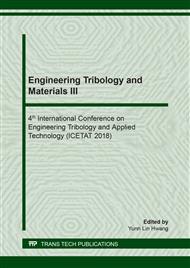p.75
p.81
p.91
p.97
p.105
p.111
p.117
p.123
p.129
Investigation of Lubrication Characteristics for a Soft Contact Lens
Abstract:
It is popular to wear the contact lens nowadays. Also, the output value of the contact lens is estimated more than 4 billion NT dollar every year. Because the phenomena of the contact lenses are very complicated, the relevant mechanisms are not well understood. Thus, the security of contact lens needs to be further investigated. In the lubricated mechanism of the contact lens, there is a layer of tear between the contact lens and cornea. The contact lens’ behavior is akin to that of a slider bearing. The lens represents the slider, the eye plays the role of the stationary pad, and the tear film is the lubricant. Hence, hydrodynamics and contact mechanisms of a contact lens are quite a fascinating subject that is relevant to the science of tribology. In the paper, the lubrication mechanisms include the partial hydrodynamic lubrication (contact lens roughness), contact mechanics and Newtonian fluid mechanics have been established. The parameters of roughness, flow factor, tear film geometry, and hydrodynamic pressure distribution are discussed. The developed technology increases the safety of contact lens.
Info:
Periodical:
Pages:
105-109
Citation:
Online since:
September 2019
Authors:
Price:
Сopyright:
© 2019 Trans Tech Publications Ltd. All Rights Reserved
Share:
Citation:


